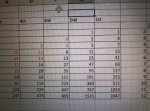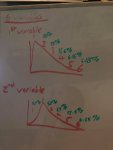Ok so after the showman attention-grabbing title for this thread, I do seriously need some help identifying the link between the following sequences please. Please open up the attached excel spreadsheet to view my sequences.
The problem is, this isn't a standard geometric sequence as non have a common ratio. I don't know whether it helps but underneath I have included the difference between each term.
I thought I had begun to crack it with the following formulas...
1st =(2^(n-1))-1
2rd =(2^(n-1)-2^(n-3))-1
3rd =(2^(n-1)-2^(n-2)-2^(n-5))-1
Feel free to type these into excel and you will see they work!!!... until you get to the point where the difference in the term before is bigger rather than smaller. Plotting these points in a graph, you can see this is because each sequence (going downwards) creates curved lines that have a low point before reversing.
To clarify, the sequences go down so first sequence:
1 3, 7, 15, 31, 63, 127, 255, 511, 1023, 2047
The ultimate goal is to list each formula and find the link between them for a system I am developing so this is a 2 or 3 step problem. Any assistance would be greatly appreciated and hopefully this is a bit of a fun brain scratcher for the likes of you on this forum
Callum
Sidenote: Wouldn't let me attached an excel spreadsheet so I've taken a screenshot.
The problem is, this isn't a standard geometric sequence as non have a common ratio. I don't know whether it helps but underneath I have included the difference between each term.
I thought I had begun to crack it with the following formulas...
1st =(2^(n-1))-1
2rd =(2^(n-1)-2^(n-3))-1
3rd =(2^(n-1)-2^(n-2)-2^(n-5))-1
Feel free to type these into excel and you will see they work!!!... until you get to the point where the difference in the term before is bigger rather than smaller. Plotting these points in a graph, you can see this is because each sequence (going downwards) creates curved lines that have a low point before reversing.
To clarify, the sequences go down so first sequence:
1 3, 7, 15, 31, 63, 127, 255, 511, 1023, 2047
The ultimate goal is to list each formula and find the link between them for a system I am developing so this is a 2 or 3 step problem. Any assistance would be greatly appreciated and hopefully this is a bit of a fun brain scratcher for the likes of you on this forum
Callum
Sidenote: Wouldn't let me attached an excel spreadsheet so I've taken a screenshot.



